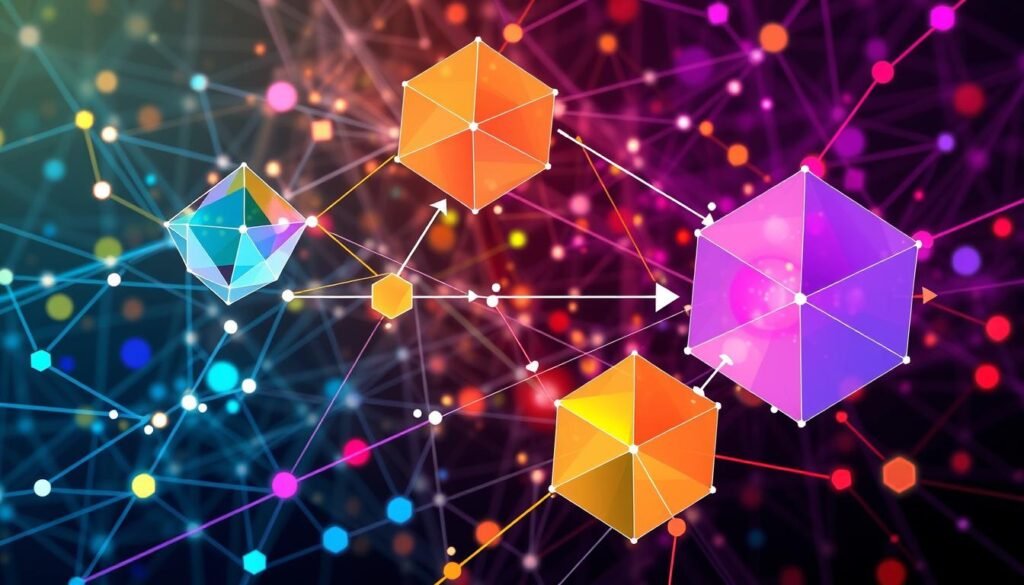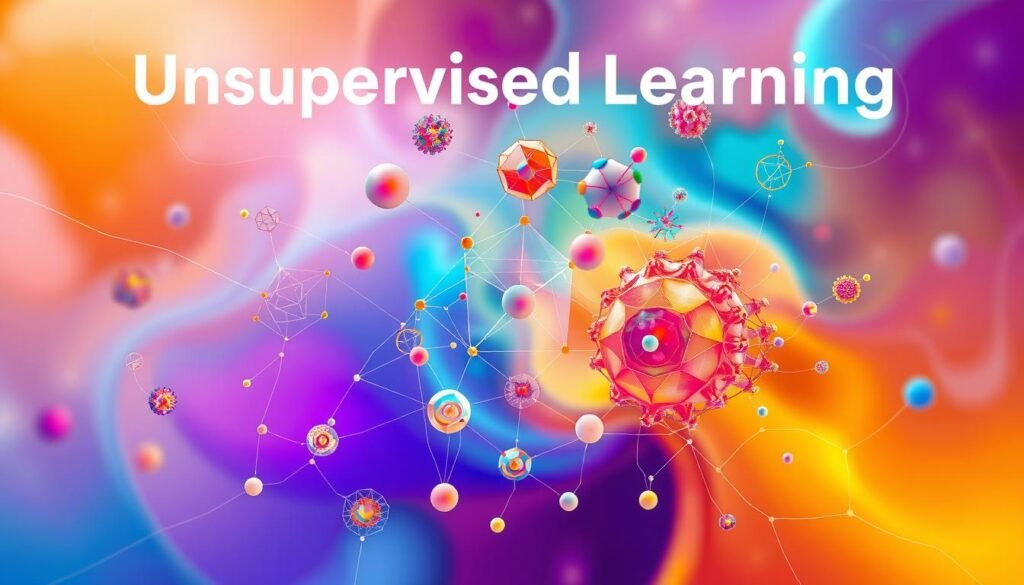Did you know machine learning algorithms are changing how we analyze data? They can handle huge amounts of information and find trends we never saw before. As someone who works with data in India, you might know how machine learning is changing industries. But have you seen how it can really help with trend analysis and making predictions?

Key Takeaways
- Machine learning algorithms let computers learn from data and make predictions. They get better over time without needing to be programmed.
- These algorithms are divided into supervised, unsupervised, and reinforcement learning. Each type is used for different tasks in data analysis.
- Supervised learning uses labeled data to train models for tasks like classification and regression. Unsupervised learning finds patterns in data without labels.
- Reinforcement learning involves agents making decisions and getting feedback to improve their actions. It’s great for complex decisions.
- Machine learning is changing how we analyze data and make decisions in many fields. It helps with trend analysis, pattern recognition, predictive modeling, and forecasting.
Understanding the Fundamentals of Machine Learning for Data Analysis
Machine learning has changed how we analyze data. It’s a part of artificial intelligence that creates algorithms to learn from data. These algorithms find patterns and trends, helping us make better decisions.
Definition and Core Concepts
Machine learning algorithms learn and get better over time. They are divided into three main types: supervised learning, unsupervised learning, and reinforcement learning. Supervised learning uses labeled data to predict outcomes. Unsupervised learning finds hidden patterns in data without labels. Reinforcement learning is about learning from experiences to get rewards.
The Role of Algorithms in Data Processing
Algorithms are key in data analysis. They look at data, find patterns, and make predictions. Common algorithms include linear regression and decision trees. These are used for data mining, predictive modeling, and time series forecasting.
Key Components of Machine Learning Systems
Good machine learning systems have a few important parts. The decision process, error function, and model optimization are crucial. The decision process makes predictions, the error function measures how accurate these are, and optimization improves the model’s performance.
Knowing how machine learning works helps businesses use it to their advantage. They can make better decisions and stay ahead in the market.
| Machine Learning Algorithm | Description | Applications |
|---|---|---|
| Linear Regression | Predicts a continuous output variable based on one or more input variables. | Forecasting, Pricing, Demand Modeling |
| Logistic Regression | Classifies data into discrete categories based on one or more input variables. | Fraud Detection, Credit Scoring, Customer Churn Prediction |
| Decision Trees | Constructs a tree-like model of decisions and their possible consequences. | Risk Assessment, Customer Segmentation, Recommendation Systems |
| Support Vector Machines (SVM) | Separates data into different classes by finding the optimal hyperplane that maximizes the margin between classes. | Image Recognition, Text Classification, Bioinformatics |
| k-Nearest Neighbors (k-NN) | Classifies data points based on the closest training examples in the feature space. | Recommendation Systems, Anomaly Detection, Image Recognition |
Which type of machine learning algorithms extract trends from data brain
Machine learning algorithms are key in finding trends and patterns in data. They work with all kinds of data, from financial to social media. The right techniques help spot important trends, predict future patterns, and find anomalies.
Supervised learning algorithms, like linear regression, logistic regression, and decision trees, are great at finding trends in labeled data. They find connections between variables, making accurate predictions and spotting patterns.
- Linear regression models find linear trends and predict future values from past data.
- Logistic regression algorithms spot non-linear trends and sort data into categories.
- Decision trees find complex patterns and rules, useful for trend analysis and anomaly detection.
Unsupervised learning algorithms, such as clustering and dimensionality reduction, find hidden patterns in unlabeled data. They’re great for exploring big, unstructured datasets and finding new relationships or groupings.
Time series analysis and forecasting methods are essential for analyzing time-series data. They help identify seasonal patterns, detect anomalies, and predict future values based on past data.
Deep learning algorithms, like neural networks, are amazing at finding complex patterns and insights in large datasets. These advanced models uncover detailed trends and relationships that traditional methods might miss.
By using machine learning, you can make the most of your data. It helps understand trends, patterns, and anomalies, leading to better decisions and plans.
Supervised Learning: Pattern Recognition and Prediction
In machine learning, supervised learning is key for recognizing patterns and predicting outcomes. These algorithms learn from labeled data, spotting trends and making precise forecasts. They help businesses uncover valuable insights from their data, whether through trend detection or forecasting.
Classification Algorithms for Trend Detection
Classification algorithms like Naive Bayes, k-Nearest Neighbors, and Random Forests are top-notch for trend detection. They learn from past examples, classifying new data into meaningful groups. This lets companies spot new trends and patterns in their data.
Regression Analysis for Data Forecasting
For predicting continuous values, predictive modeling techniques like linear and logistic regression are used. These classification algorithms study variable relationships. This helps businesses forecast future data and make decisions based on data insights.
Support Vector Machines and Decision Trees
Support Vector Machines (SVMs) and Decision Trees are also crucial in supervised learning. SVMs excel in both classification and regression, especially in complex data. Decision Trees and their variants, like Random Forests and Gradient Boosting, tackle a variety of pattern recognition and predictive modeling challenges.
Using these supervised learning methods, companies can better understand their data. They can spot trends and make accurate predictions. This is vital for making data-driven decisions and staying competitive.

Unsupervised Learning: Discovering Hidden Patterns
In machine learning, unsupervised learning algorithms are key. They find hidden patterns in big datasets. Unlike supervised learning, they work with data that isn’t labeled. This lets them find insights that might not be obvious.
Clustering is a big part of unsupervised learning. Algorithms like K-means and hierarchical clustering group similar data. This helps find different groups or clusters in a dataset. It’s useful for things like market segmentation and image grouping.
Dimensionality reduction, like PCA and t-SNE, makes high-dimensional data easier to understand. They find the main patterns and structures. This is great for tasks like feature extraction and anomaly detection.
Anomaly detection finds unusual patterns or outliers in data. It’s used in many areas, like cybersecurity. It helps spot potential threats or oddities.
Association rule learning finds interesting connections between variables in big databases. Algorithms like Apriori and FP-growth are used for this. It’s useful for market basket analysis and making recommendations.
Unsupervised learning is more than just finding patterns. It’s also key for making advanced AI, like generative AI and search engines. It helps us understand and use the vast data we have today.

Advanced Trend Analysis Techniques
Data analysis has changed a lot thanks to machine learning (ML) and artificial intelligence (AI). New methods like time series forecasting, deep learning, and ensemble methods have changed how we find insights in big data.
Time Series Analysis and Forecasting
Time series analysis is now a key tool for understanding and predicting trends in data over time. Tools like ARIMA and Prophet use past data to forecast future trends. They are used in finance, retail, and climate studies to predict market trends, consumer behavior, and environmental changes.
Deep Learning for Complex Pattern Recognition
Deep learning has improved our ability to spot complex patterns in big data. Convolutional Neural Networks (CNNs) and Recurrent Neural Networks (RNNs) are great at analyzing images, text, and other data. They are very useful in trend analysis in social media, healthcare, and marketing.
Ensemble Methods for Improved Accuracy
Data scientists use ensemble methods to make trend analysis more accurate and reliable. Techniques like Random Forests, Gradient Boosting, and XGBoost combine different models to get better results in trend detection and prediction.
These advanced techniques help businesses and researchers find valuable insights and make better decisions. The use of time series forecasting, deep learning, and ensemble methods has changed trend analysis. It’s now a powerful tool for strategic success in a fast-changing world.
Conclusion
Machine learning algorithms are key in finding important trends and patterns in big datasets. They use both supervised and unsupervised learning to analyze data. This helps businesses and organizations make better decisions.
The world of artificial intelligence is growing fast. New algorithms and methods are being created to deal with complex data. The right algorithm depends on the problem, the data, and what you want to achieve.
As research in machine learning goes on, we’ll see even better ways to analyze trends. This will help you use data brain trend analysis for many things. From marketing to improving supply chains, staying up-to-date with machine learning will help your organization succeed.
FAQ
What are machine learning algorithms and how do they work?
Machine learning algorithms are instructions for computers to learn from data. They make predictions and get better over time without being programmed. There are three main types: supervised, unsupervised, and reinforcement learning.
Supervised learning uses labeled data for tasks like classification and regression. Unsupervised learning finds hidden patterns in data without labels. Reinforcement learning involves agents making decisions based on feedback to improve their actions.
What is the role of algorithms in data processing?
Algorithms are key in data processing. They analyze data, find patterns, and make predictions or classifications. The main parts of machine learning systems are the decision process, error function, and model optimization.
What types of machine learning algorithms can extract trends from data?
Many algorithms can find trends in data. Supervised learning algorithms like linear regression and decision trees work with labeled data. Unsupervised learning algorithms, such as clustering, find patterns in unlabeled data.
Time series analysis is great for trends in temporal data. Deep learning, including neural networks, can find complex patterns in large datasets.
How do supervised learning algorithms detect trends?
Supervised learning algorithms are trained on labeled data. They recognize patterns and make predictions. Classification algorithms like Naive Bayes and Random Forests are used for trend detection.
Regression analysis, including linear and logistic regression, is for forecasting. Support Vector Machines (SVM) are good for both classification and regression. Decision trees and their ensemble methods are powerful for various tasks.
What types of unsupervised learning algorithms are used for trend analysis?
Unsupervised learning algorithms find hidden patterns in data. Clustering algorithms group similar data points. Dimensionality reduction techniques like PCA and t-SNE help visualize data.
Anomaly detection finds unusual patterns. Association rule learning discovers interesting relationships in large databases.
What are some advanced techniques for trend analysis?
Advanced techniques use sophisticated algorithms. Time series analysis and forecasting methods, like ARIMA and Prophet, analyze temporal data. Deep learning techniques, including CNNs and RNNs, find complex patterns in large datasets.
Ensemble methods like Random Forests and Gradient Boosting combine models for better accuracy and robustness in trend detection and prediction.
Also Read
Artificial intelligence and machine learning examples for students
